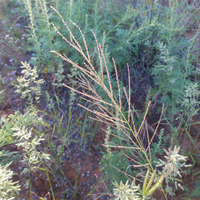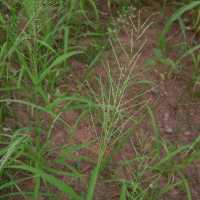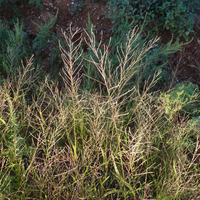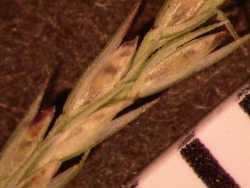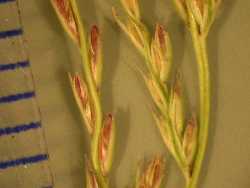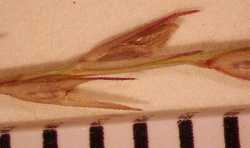Plants annual. Culms (5)13-150 cm, usually erect, compressed, branching; internodes hollow. Sheaths sparsely or densely hairy, particularly distally, hairs papillose-based; ligules 0.6-3.2 mm, membranous, truncate, erose; blades 6-25 cm long, 2-21 mm wide, glabrous or sparsely pilose on both surfaces. Panicles 8-30 cm, with 3-100 racemose branches; branches 1-19 cm, ascending to reflexed. Spikelets 2-4 mm, distant to imbricate, green, magenta, or maroon, with 2-5(6) florets. Glumes sometimes exceeding the florets, linear to narrowly elliptic, acute, attenuate, or aristate; lower glumes 1.6-4 mm, linear to lanceolate; upper glumes 1.6-3.6 mm, lanceolate; lemmas 0.9-1.7 mm, glabrous or somewhat sericeous, acute to obtuse; paleas glabrous or sericeous; anthers 3, 0.2-0.3 mm. Caryopses 0.8-1.2 mm long, 0.5-0.6 mm wide, nearly round in cross section, with or without a ventral groove, apices acute to broadly obtuse.
Leptochloa panicea is a cosmopolitan species that somewhat resembles L. chinensis, an aggressive weed that has not yet been found in the Flora region. It differs in its sparsely to densely hairy, rather than glabrous or almost glabrous, sheaths and blades. Two of its three subspecies grow in the Flora region.
Annuals, Terrestrial, not aquatic, Stems nodes swollen or brittle, Stems geniculate, decumbent, or lax, sometimes rooting at nodes, Stems caespitose, tufted, or clustered, Stems terete, round in cross section, or polygonal, Stems compressed, flattened, or sulcate, Stems branching above base or distally at nodes, Stem internodes hollow, Stems with inflorescence less than 1 m tall, Stems with inflorescence 1-2 m tall, Stems, culms, or scapes exceeding basal leaves, Leaves mostly cauline, Leaves conspicuously 2-ranked, distichous, Leaves sheathing at base, Leaf sheath mostly open, or loose, Leaf sheath hairy, hispid or prickly, Leaf sheath hairy at summit, throat, or collar, Leaf sheath and blade differentiated, Leaf blades linear, Leaf blades very narrow or filiform, less than 2 mm wide, Leaf blades 2-10 mm wide, Leaf blades mostly flat, Leaf blade margins folded, involute, or conduplicate, Leaf blades more or less hairy, Ligule present, Ligule an unfringed eciliate membrane, Inflorescence terminal, Inflorescence solitary, with 1 spike, fascicle, glomerule, head, or cluster per stem or culm, Inflorescence a panicle with narrowly racemose or spicate branches, Inflorescence branches more than 10 to numerous, Inflorescence branches 1-sided, Flowers bisexual, Spikelets sessile or subsessile, Spikelets laterally compressed, Spikelet less than 3 mm wide, Spikelets with 2 florets, Spikelets with 3-7 florets, Spikelets solitary at rachis nodes, Spikelets all alike and fertille, Spikelets bisexual, Spikelets disarticulating above the glumes, glumes persistent, Spikelets disarticulating beneath or between the florets, Spikelets secund, in rows on one side of rachis, Rachilla or pedicel glabrous, Glumes present, empty bracts, Glumes 2 clearly present, Glumes distinctly unequal, Glumes shorter than adjacent lemma, Glume equal to or longer than spikelet, Glumes keeled or winged, Glumes 1 nerved, Lemmas thin, chartaceous, hyaline, cartilaginous, or membranous, Lemma 3 nerved, Lemma body or surface hairy, Lemma apex truncate, rounded, or obtuse, Lemma apex dentate, 2-fid, Lemma awnless, Lemma straight, Palea present, well developed, Palea membranous, hyaline, Palea about equal to lemma, Palea 2 nerved or 2 keeled, Stamens 3, Styles 2-fid, deeply 2-branched, Stigmas 2, Fruit - caryopsis.
Common Name: mucronate sprangletop
Duration: Annual
Nativity: Native
Lifeform: Graminoid
General: Cespitose annual grass with erect, compressed stems, 13-150 cm long.
Vegetative: Sheaths sparsely or densely hairy, particularly distally, with papillose-based hairs; ligule a ciliate membrane 0.6-3 mm long; blades elongate, 3-25 cm long, 1-7 mm wide, glabrous or sparsely pilose on both sides, apex attenuate.
Inflorescence: Numerous racemose branches borne along a central axis; the axis straight, unilateral, 8-30 cm long; branches 1-19 cm long, ascending to reflexed, with 2 rows of spikelets; spikelets 2-4 mm with 2-5 florets, green, magenta, or maroon; glumes sometimes exceeding florets, linear to narrowly elliptic, acute, attenuate, or aristate; lemmas 1-2 mm, glabrous or sericeous; paleas glabrous or sericeous; caryopsis ellipsoid, 0.5 mm long, dark brown.
Ecology: Found in moist habitats of wetlands, swamps, and open lowland soils; also an agricultural weed; from 1,000-5,000 ft (305-1524 m); flowers May-September.
Distribution: Cosmopolitan; In much of the southern half of the US from s CA east to MD; south through the Caribbean, MEX, to South America; naturalized in Africa and Australia.
Notes: An erect annual grass, the sheathes and blades have sparse to dense long hairs with enlarged (papillose) bases; an inflorescence composed of a single axis with many ascending to spreading narrow branches, each branch with 2 rows of appressed multi-flowered spikelets. Subspecies mucronata is told apart by its linear to narrowly lanceolate glumes which are longer than the florets and caryopses without a ventral groove. Subspecies brachiata has shorter glumes and caryopses with a ventral groove. This species is distinguished from Leptochloa fusca (Dinebra fusca), another Sonoran Desert annual, by its small spikelets, 2-4 mm long (5-12 mm in L. fusca) and often reddish panicle. Leptochloa viscida (Dinebra viscida) is another annual with reddish spikelets, but that species has a small, dense panicle, 3-8 cm long.
Ethnobotany: Unknown
Etymology: Leptochloa is from Greek leptos, slender and chloe or chloa, grass, while panicea is of uncertain orgins.
Synonyms: Leptochloa attenuata, Dinebra panicea, Leptochloa filiformis, many others, see Tropicos
Editor: SBuckley 2010, FSCoburn 2014, AHazelton 2015



